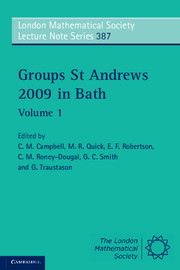Book contents
- Frontmatter
- Contents
- Introduction
- A speech in honour of John Cannon and Derek Holt
- Finite groups of Lie type and their representations
- Iterated monodromy groups
- Engel elements in groups
- Some classes of finite semigroups with kite-like egg-boxes of D-classes
- Structure of finite groups having few conjugacy class sizes
- Group theory in cryptography
- A survey of recent results in groups and orderings: word problems, embeddings and amalgamations
- A survey on the minimum genus and maximum order problems for bordered Klein surfaces
- On one-relator quotients of the modular group
- Miscellaneous results on supersolvable groups
- Automorphisms of products of finite groups
- A rational property of the irreducible characters of a finite group
- Automotives
- On n-abelian groups and their generalizations
- Computing with matrix groups over infinite fields
- Trends in infinite dimensional linear groups
- Engel conditions on orderable groups and in combinatorial problems (a survey)
- References
A survey of recent results in groups and orderings: word problems, embeddings and amalgamations
Published online by Cambridge University Press: 05 July 2011
- Frontmatter
- Contents
- Introduction
- A speech in honour of John Cannon and Derek Holt
- Finite groups of Lie type and their representations
- Iterated monodromy groups
- Engel elements in groups
- Some classes of finite semigroups with kite-like egg-boxes of D-classes
- Structure of finite groups having few conjugacy class sizes
- Group theory in cryptography
- A survey of recent results in groups and orderings: word problems, embeddings and amalgamations
- A survey on the minimum genus and maximum order problems for bordered Klein surfaces
- On one-relator quotients of the modular group
- Miscellaneous results on supersolvable groups
- Automorphisms of products of finite groups
- A rational property of the irreducible characters of a finite group
- Automotives
- On n-abelian groups and their generalizations
- Computing with matrix groups over infinite fields
- Trends in infinite dimensional linear groups
- Engel conditions on orderable groups and in combinatorial problems (a survey)
- References
Summary
Introduction
This year we celebrate the centenaries of the births of B. H. Neumann and A. I. Mal'cev, two great pioneers in the study of ordered algebraic structures. This paper is a survey of our recent progress in this area, and amplifies the talks we gave in Bath at the Groups St. Andrews Conference there, and the first author gave at the Mal'cev Centenary Conference in Novosibirsk. A version of this paper in Russian will appear in honour of the Mal'cev Centenary and the 80th anniversary of A. I. Kokorin, another pioneer in the subject (Izvestia of Irkutsk Sate University, Series Matematika, Vol. 2 (2009), No. 2, 4–19). The heart of the paper for pure group theorists is Section 4.
Groups versus Lattice-ordered Groups
One way to obtain results in infinite group theory is through spelling and associated constructions, such as free groups, free products, free products with amalgamated subgroups, and HNN-extensions [23]. The first two constructions are available in any variety of algebras, but for groups they are especially nice. This is for two reasons. The first is that every element of a free group has a unique easily obtained reduced spelling in terms of the generators and there is, similarly, a unique normal form for elements of a free product. Moreover, given any groups G1 and G2 with isomorphic subgroups H1 and H2, respectively (say φ : H1 ≅ H2), there is a group L and embeddings Τi : Gi → L (i = 1, 2) such that h1Τ1 = h1φΤ2 for all h1 ∈ H1.
- Type
- Chapter
- Information
- Groups St Andrews 2009 in Bath , pp. 150 - 160Publisher: Cambridge University PressPrint publication year: 2011
References
- 1
- Cited by

